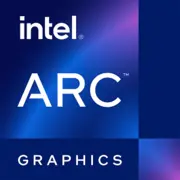Intel Arc A370M

Intel Arc A370M: Detailed Review of the 2025 Mobile GPU
Introduction
Intel's Arc graphics cards have become an important player in the discrete graphics market, offering an alternative to NVIDIA and AMD solutions. In this article, we will explore the mobile version — Intel Arc A370M, which remains popular among budget gaming laptops and workstations even in 2025. We will examine its architecture, performance, energy efficiency, and practical value.
1. Architecture and Key Features
Xe-HPG Architecture
The A370M is built on the Xe-HPG (High-Performance Gaming) microarchitecture, optimized for gaming and professional tasks. The chips are manufactured using a 6nm TSMC process, providing a balance between energy efficiency and performance.
Unique Features
- Ray Tracing (RT): Supports hardware-accelerated ray tracing, although it has fewer RT cores compared to NVIDIA's flagship models.
- XeSS (Xe Super Sampling): Upscaling technology similar to DLSS and FSR. It allows for a 30-50% increase in FPS at 4K without significant loss of detail.
- Compatibility with FidelityFX: Works with open standards from AMD, including FSR 3.0, which expands the list of supported games.
2. Memory: Type, Capacity, and Speed
GDDR6 and Bandwidth
The A370M is equipped with 4 GB of GDDR6 memory and a 128-bit bus. The memory bandwidth reaches 224 GB/s (14 Gbps × 128 bits / 8). This is sufficient for most games at 1080p, but in 2025, 4 GB may become a bottleneck for projects with ultra textures or when working with professional applications.
Impact on Performance
- In Cyberpunk 2077 (1080p, Ultra), memory usage rarely exceeds 3.5 GB, but in Horizon Forbidden West (1440p, RT On), stuttering may occur due to VRAM limitations.
- For 4K video editing in DaVinci Resolve, 4 GB is the minimum threshold.
3. Gaming Performance
Average FPS in Popular Games (1080p)
- Fortnite (Epic, XeSS Quality): 75-90 FPS.
- Call of Duty: Modern Warfare V (Ultra, RT Off): 60-70 FPS.
- Cyberpunk 2077 (High, RT Medium + XeSS Balanced): 45-55 FPS.
Resolution Support
- 1080p: Ideal choice for the A370M.
- 1440p: Requires reducing settings to Medium or using XeSS/FSR.
- 4K: Only feasible in less demanding games (e.g., CS2, Dota 2).
Ray Tracing
Enabling RT reduces FPS by 25-40%, but losses are compensated with XeSS. For instance, in Minecraft RTX, the card provides a stable 30 FPS at XeSS Performance.
4. Professional Tasks
Video Editing and Rendering
- Premiere Pro: Rendering acceleration thanks to Intel Quick Sync support. Exporting a 10-minute 4K video takes ~8 minutes.
- Blender: In the BMW CPU + GPU test, rendering completes in 14 minutes (compared to 9 minutes with the RTX 3050).
Scientific Calculations
- Supports OpenCL and oneAPI, but CUDA-optimized tasks (e.g., in MATLAB) run slower than on NVIDIA.
5. Power Consumption and Heat Dissipation
TDP and Cooling Recommendations
- The A370M has a TDP of 50-75 W, making it suitable for slim laptops.
- In gaming scenarios, temperatures reach 75-85°C, so an effective cooling system with 2-3 heat pipes is essential.
Case Selection Tips
For laptops with the A370M, models with rear ventilation holes and adjustable performance modes (e.g., ASUS TUF Dash F15) are preferred.
6. Comparison with Competitors
NVIDIA RTX 3050 Mobile
- NVIDIA Advantages: Better driver optimization, DLSS 3.5, higher FPS in RT scenes.
- Intel Advantages: Lower price (~$300 vs. $400), AV1 encoding support.
AMD Radeon RX 6600M
- AMD Advantages: 8 GB VRAM, better performance at 1440p.
- Intel Advantages: Energy efficiency, XeSS.
7. Practical Tips
Power Supply
A 120-150 W adapter is sufficient for a laptop with the A370M. However, when simultaneously stressing both the CPU and GPU (e.g., while streaming), it's better to have a power reserve.
Compatibility
- Platforms: Works best in tandem with Intel's 12th-generation processors and newer (optimization through Deep Link).
- Drivers: By 2025, stability has improved, but artifacts may still occur in older games (pre-2022).
8. Pros and Cons
Pros
- Affordable price ($300-400 for laptops).
- Support for modern technologies: RT, XeSS, AV1.
- Low power consumption.
Cons
- Only 4 GB VRAM.
- Limited performance at 4K.
- Drivers still lag behind NVIDIA in optimization.
9. Final Conclusion: Who Should Get the A370M?
This graphics card is an excellent choice for:
- Budget gamers looking to play at 1080p with high settings.
- Students and professionals needing a laptop for video editing and 3D modeling without overspending.
- Technology enthusiasts wanting to try an alternative to NVIDIA/AMD.
Conclusion: The Intel Arc A370M proves that even in 2025, one can achieve a respectable gaming experience and work capabilities without purchasing top-tier GPUs. The key is to consider its limitations and leverage strengths like XeSS and energy efficiency.
Basic
Memory Specifications
Theoretical Performance
Miscellaneous
Benchmarks
Compared to Other GPU
Share in social media
Or Link To Us
<a href="https://cputronic.com/en/gpu/intel-arc-a370m" target="_blank">Intel Arc A370M</a>